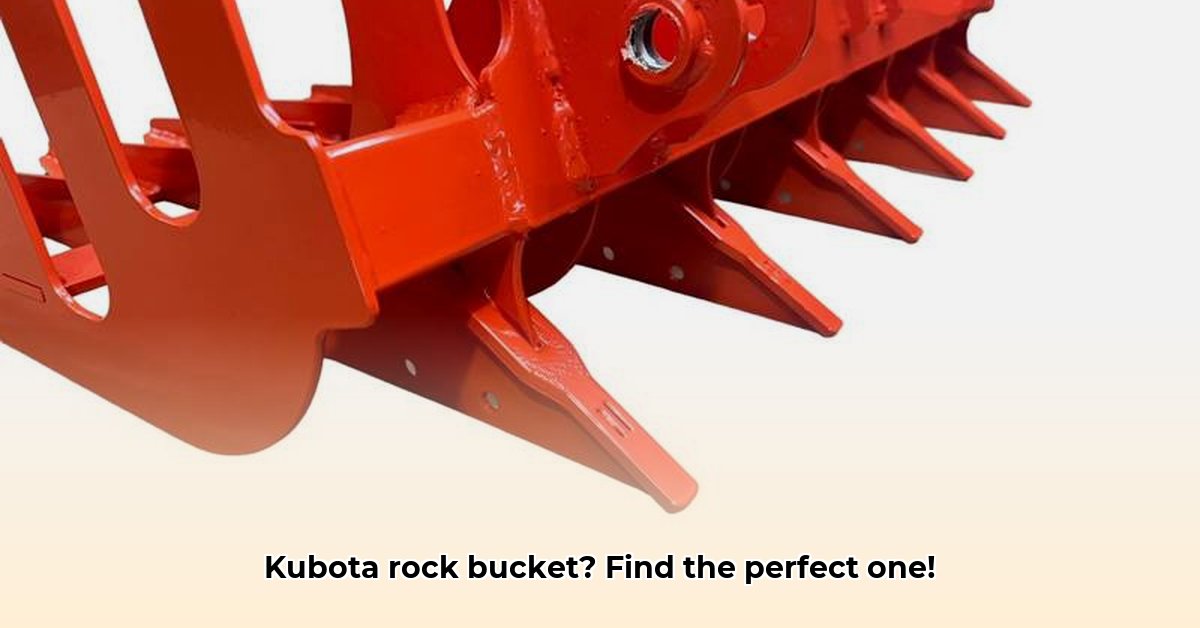
Choosing the right rock bucket for your Kubota BX tractor is crucial for efficient and safe operation. This comprehensive guide will walk you through selecting, installing, and maintaining the perfect bucket for your needs, whether you're a landscaper, farmer, or homeowner tackling a tough project. For more information on Kubota BX tractors, check out this helpful resource: Kubota BX info.
Understanding Your Kubota BX Rock Bucket Options
Several factors determine the ideal rock bucket for your Kubota BX. Let's explore the key considerations:
Capacity: How Much Can It Hold?
Bucket capacity directly impacts productivity. Larger buckets move more material quickly, ideal for large-scale projects. Smaller buckets are more maneuverable in tight spaces, perfect for smaller jobs or delicate landscaping. Consider the typical volume of material you'll be handling. Do you need to shift tons of rock, or are you working on a smaller landscaping project?
Tine Spacing: Fine-Tuning Your Approach
Tine spacing (the distance between the bucket's teeth) significantly impacts material handling. 2-inch spacing is best suited for finer materials like gravel or smaller rocks, acting almost like a sieve. 3-inch spacing is designed for larger rocks and debris. Think of it this way: 2-inch spacing is for pebbles, and 3-inch spacing is for boulders. Which best suits your needs?
Mounting Systems: Pin-on vs. Quick-Attach
Two primary mounting systems exist: pin-on and quick-attach. Pin-on systems, using bolts and pins, are generally less expensive and potentially more durable, requiring simple, reliable attachment. Quick-attach systems allow for faster attachment changes, offering greater versatility but often at a higher initial cost and with increased complexity. Always confirm compatibility with your specific Kubota BX model.
Materials: The Strength of Steel
A36 steel is a common, cost-effective material for rock buckets, offering a good balance of strength and durability. However, some manufacturers might use different, stronger, or more specialized steels, potentially influencing both cost and longevity. Research different manufacturers' choices carefully to determine what best suits your needs.
Manufacturers: A Range of Choices
Several reputable manufacturers produce Kubota BX rock buckets, including Redline Systems and others. Each manufacturer may offer unique features, affecting price and performance. Thorough research and comparison-shopping are key to finding the best fit for your requirements. Look at user reviews for real-world feedback.
Your Kubota BX Rock Bucket Buying Guide: A Step-by-Step Approach
Choosing the right bucket requires careful consideration. Follow these steps:
Verify Tractor Compatibility: Always confirm that the chosen bucket is compatible with your specific Kubota BX model. Consult manufacturer specifications or compatibility charts. Avoid potential issues by carefully reviewing this information.
Define Your Tasks: Clearly define how you'll use the bucket. Will you be tackling large rocks or fine landscaping materials? This will greatly influence your choice of size and tine spacing. Understanding this is critical for selecting the optimal bucket.
Establish a Budget: Rock buckets vary considerably in price. Determine a realistic price range before you start your research, ensuring you find a bucket that fits your budget without compromising quality.
Assess Warranty and Maintenance: A strong warranty protects your investment. Understand the maintenance requirements (lubrication, part replacement) to maximize your bucket’s lifespan and minimize unexpected costs. A well-maintained bucket costs less in the long run.
Installing and Using Your Rock Bucket Safely
Safe operation is paramount. Follow these steps:
Secure Attachment: Carefully follow the manufacturer's instructions for attaching the bucket to your Kubota BX. Double-check all connections before operation.
Stable Ground Only: Always operate on level, stable ground. Avoid slopes or uneven terrain to maintain stability and prevent accidents.
Avoid Overloading: Never exceed the bucket's rated capacity. Overloading risks damage to the bucket, the tractor, or even injury.
Maintain Safe Distances: Never approach moving parts of the bucket or tractor while in operation. Stay clear of the bucket’s operational area.
Safe Detachment: Always ensure the bucket is completely stationary and empty before detaching it from your tractor. This is a critical step for safety.
Maintaining and Troubleshooting Your Rock Bucket
Regular maintenance extends your bucket's lifespan.
Regular Inspections: Inspect the bucket regularly (after each use) for dents, cracks, or bent tines. Early detection of issues allows for timely repair.
Lubrication: Lubricate all moving parts, such as pins and hinges, as recommended by the manufacturer. This will dramatically reduce wear and tear.
Prompt Repair: Replace worn or damaged parts immediately. Delaying repairs can lead to more extensive and costly damage down the line. Address issues early before problems compound.
Conclusion: The Right Bucket for the Right Job
Choosing the right rock bucket depends on careful consideration of your tractor model, intended use, and budget. Prioritize safety in both operation and maintenance to extend the life of your equipment and ensure efficient, safe work. Remember to always consult manufacturer instructions and reviews before selecting and purchasing a rock bucket.